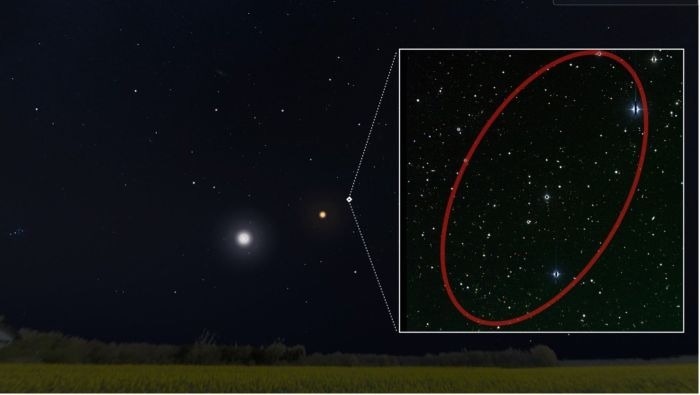A research team at Tohoku University has performed the inaugural systematic search for optical counterparts to a neutrino "multiplet," which is a rare occurrence where several high-energy neutrinos are detected from the same direction in a brief timeframe. This event was recorded by the IceCube Neutrino Observatory, a large detector located deep within the Antarctic ice. The study was published in The Astrophysical Journal.
 Arrival direction of a high-energy neutrino multiplet event determined by the IceCube experiment, overlaid on the visible night sky (generated with Stellarium). The right panel shows a zoomed-in optical image of the same region. The red ellipse indicates the 1σ uncertainty estimated by IceCube. Image Credit: ©Stellarium, Zwicky Transient Facility
Arrival direction of a high-energy neutrino multiplet event determined by the IceCube experiment, overlaid on the visible night sky (generated with Stellarium). The right panel shows a zoomed-in optical image of the same region. The red ellipse indicates the 1σ uncertainty estimated by IceCube. Image Credit: ©Stellarium, Zwicky Transient Facility
The origins of the extremely high-energy particles that permeate the Universe, including protons, electrons, and neutrinos, continue to be one of the most enduring enigmas in contemporary astrophysics. A prominent theory proposes that "explosive transients," such as massive stellar explosions (supernovae) and tidal disruption events (TDE) resulting from stars being ripped apart by black holes, may serve as the cosmic engines responsible for generating these energetic particles. However, this concept has yet to undergo thorough testing.
The team was directed by Seiji Toshikage, a graduate student at the Graduate School of Science at Tohoku University, alongside Shigeo Kimura, a professor at the Frontier Research Institute for Interdisciplinary Sciences (FRIS) at Tohoku University, and Masaomi Tanaka, who is also affiliated with the Graduate School of Science at Tohoku University.
Through the analysis of wide-field optical data that aligned both spatially and temporally with the neutrino multiplet, the researchers aimed to uncover visible evidence of potential astrophysical sources. Nevertheless, their study revealed no signs of supernovae, tidal disruption events (TDEs), or other explosive transients at the relevant times and locations.
The lack of optical counterparts is, ironically, very informative. The non-detection enables the team to impose stronger constraints than previously possible regarding the brightness and duration of such explosive events, should they generate neutrino multiplets. These results considerably reduce the potential sources of the Universe's most energetic particles and represent a crucial advancement in addressing one of the most fundamental mysteries in astrophysics.
Although we didn't find any transient sources this time, our results show that even non-detections can provide powerful insights. They help us refine our models and guide future searches for the true sources of high-energy neutrinos.
Seiji Toshikage, Graduate Student, Graduate School of Science, Tohoku University
In the future, the team intends to perform swift optical follow-up observations of newly identified neutrino multiplets immediately after they are reported by the IceCube collaboration. They anticipate that these initiatives, which are based on the analytical techniques established in this research, will assist scientists in getting closer to pinpointing the astrophysical sources responsible for producing high-energy particles across the Universe.
Journal Reference:
Toshikage, S., et al. (2025) The First Search for Optical Transient as a Counterpart of a Month-timescale IceCube Neutrino Multiplet Event. The Astrophysical Journal. doi/article/10.3847/1538-4357/adfedf.